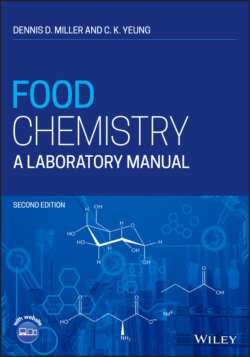Читать книгу Food Chemistry - Dennis D. Miller - Страница 32
2.2.2 Neutralizing Values
ОглавлениеNeutralizing values (NV) of leavening acids are used to compare the available acidity of the acids and to calculate the amount of acid needed in a given formulation of chemically leavened product. Neutralizing value is defined as the weight of NaHCO3 that can be neutralized by 100 parts of the leavening acid. For example, if 100 g of an acid will neutralize 50 g of NaHCO3, the neutralizing value of the acid is 50. NV are determined by titrating to a specific pH endpoint [6]. The formula for NV is:
(7)
whereb = wt of NaHCO3 neutralized;
a = wt of acid required to neutralize b.
See Table 2.1 for NV for some common leavening acids.
Table 2.1 Neutralizing values for some common leavening acidsa.
| Leavening acid | Molecular weight | Neutralizing value | Reaction rateb |
|---|---|---|---|
| Monocalcium phosphate monohydrate (MCP) | 252 | 80 | Fast |
| Delayed anhydrous monocalcium phosphate (AMCP) | 234 | 82 | Slow |
| Sodium acid pyrophosphate (SAPP) | 222 | 72 | Slow |
| Sodium aluminum phosphate (SALP) | 950 | 100 | Slow |
| Dicalcium phosphate dihydrate (DCP) | 172 | 33 | Slow |
| Sodium aluminum sulfate (SAS) | 484 | 104 | Slow |
| Fumaric acid | 116 | 145 | Fast |
| Potassium acid tartrate | 188 | 50 | Medium |
| Glucono‐delta‐lactone | 178 | 45 | Slow |
a Adapted from [4] and [7].
b Rate of reaction with NaHCO3 at room temperature.
NV are used to determine the amount of acid needed to neutralize a given amount of NaHCO3. For example, if a formula specifies 20 kg of NaHCO3, the amount of SAS (NV = 104) required would be:
(8)
Baking powders and recipes are generally formulated to give baked products with near‐neutral pHs. There are, however, some exceptions to this:
1 Devil's Food Chocolate Cake. Excess sodium bicarbonate is added to give an alkaline pH in order for the chocolate to form the characteristic deep red color.
2 Buttermilk products. Excess acid (in the form of buttermilk) is added to give the characteristic flavor.
3 Pretzels and Gingerbread. Alkaline pHs are produced to accelerate nonenzymatic browning reactions which are important for the deep brown color.
